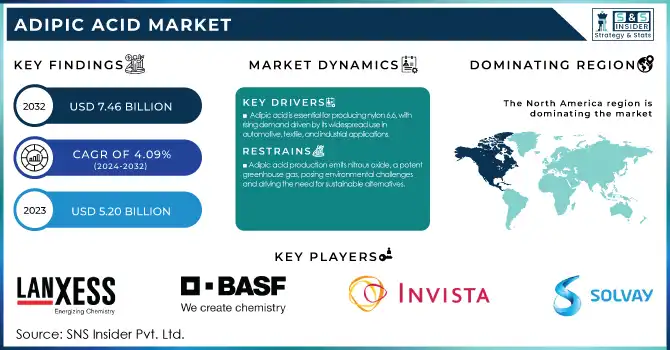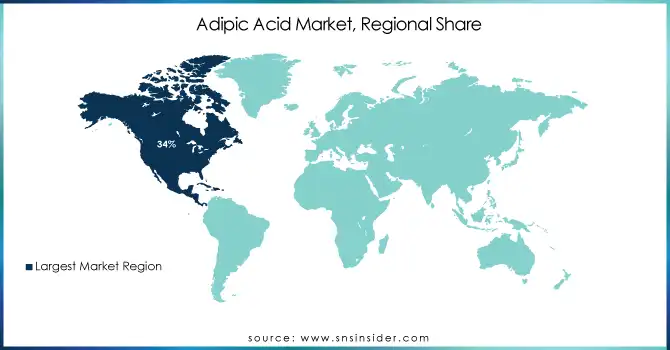Adipic Acid Market Report Scope & Overview:
The Adipic Acid Market size was valued at USD 5.20 billion in 2023. It is estimated to hit USD 7.46 billion by 2032 and grow at a CAGR of 4.09% over the forecast period of 2024-2032.

Get E-PDF Sample Report on Adipic Acid Market - Request Sample Report
The adipic acid market growth is driven primarily by its extensive use in the production of nylon 6,6, polyurethane foams, and plasticizers. Adipic acid is a versatile compound, valued for its role in improving durability, flexibility, and performance in various applications. Key industries fueling its demand include automotive, textiles, packaging, and construction. A significant trend in the market is the growing emphasis on sustainability. With rising environmental concerns, manufacturers are increasingly focusing on bio-based adipic acid production methods to reduce carbon emissions and dependency on fossil fuels. Technological advancements in fermentation and bio-catalysis are contributing to this shift. Additionally, the adoption of adipic acid in producing lightweight materials for automotive applications aligns with the global push for energy efficiency and reduced fuel consumption.
The market is also witnessing a rise in demand for adipic acid in polyurethane applications, driven by its use in flexible and rigid foams for insulation, furniture, and automotive interiors. The expansion of the construction sector and the increasing demand for energy-efficient buildings are further propelling its growth. According to research, over 85% of adipic acid production is consumed in the nylon 6,6 market, underscoring its critical role in textiles and engineering plastics. The global production capacity of adipic acid has been steadily increasing, supported by investments in both traditional and bio-based production facilities.
MARKET DYNAMICS
DRIVERS
- Adipic acid is essential for producing nylon 6,6, with rising demand driven by its widespread use in automotive, textile, and industrial applications.
Adipic acid serves as a vital raw material in the production of nylon 6,6, a versatile polymer extensively utilized in various industries. The automotive sector relies on nylon 6,6 for manufacturing lightweight, durable components such as air intake manifolds, radiator end tanks, and fuel system parts, contributing to improved vehicle efficiency and performance. Simultaneously, the textile industry employs nylon 6,6 in producing high-strength fibers for garments, upholstery, and industrial fabrics. The growing demand for durable, lightweight materials in automotive applications and the increasing consumer preference for high-quality textiles are key factors driving the demand for nylon 6,6. This, in turn, propels the adipic acid market, as it is indispensable in the polymer’s production process. With advancements in manufacturing and expanding end-use applications, the demand for adipic acid in the nylon industry is expected to maintain steady growth, reinforcing its importance in modern industrial and consumer products.
RESTRAINT
- Adipic acid production emits nitrous oxide, a potent greenhouse gas, posing environmental challenges and driving the need for sustainable alternatives.
The conventional production of adipic acid, primarily through the oxidation of cyclohexane, generates significant emissions of nitrous oxide (N₂O), a greenhouse gas with a global warming potential approximately 300 times greater than carbon dioxide (CO₂). This has raised substantial environmental concerns, as N₂O emissions contribute to climate change and ozone layer depletion. Regulatory authorities worldwide are increasingly imposing strict environmental regulations to limit these emissions, creating challenges for manufacturers to comply while maintaining cost-effectiveness. Additionally, the growing emphasis on sustainability has led to mounting pressure on the chemical industry to adopt cleaner, greener production methods. Efforts are underway to develop bio-based and low-emission production technologies, but these often involve higher costs and technological complexities. As a result, balancing environmental responsibility with economic feasibility remains a critical hurdle for the adipic acid market, compelling stakeholders to innovate and invest in sustainable alternatives.
MARKET SEGMENTATION
By Product
Nylon 6,6 Fiber segment dominated with the market share over 54% in 2023, which holds the largest market share, driven by its high demand in industries such as automotive and textiles. This segment is also the fastest-growing due to the increasing need for durable and lightweight materials. The Nylon 6,6 Resin segment also holds a significant share, with applications in engineering plastics and automotive components. While other segments, such as Adipate Esters and Polyurethane, contribute to the market, the growth and dominance of the Nylon 6,6 Fiber segment are the most notable in the adipic acid market.
By End-user Industry
The automotive segment significantly drives the demand for adipic acid, primarily used in producing nylon 66, a strong and durable polymer. Nylon 66 is crucial for automotive applications such as tire cords, airbags, and engine components due to its resistance to abrasion and high-performance characteristics. The growing demand for lightweight, durable materials in vehicles further accelerates adipic acid consumption in this sector. As automotive manufacturers continue to focus on enhancing vehicle safety, fuel efficiency, and performance, adipic acid's role in producing essential components, such as airbags and tire cords, continues to grow, reinforcing its importance in the industry.
KEY REGIONAL ANALYSIS
North America region dominated with the market share over 34% in 2023. This market leadership can be attributed to the region’s robust manufacturing infrastructure, which allows for the efficient production of adipic acid to meet increasing demand across various industries. The region’s commitment to research and development (R&D) plays a crucial role in its market dominance, as significant investments in technological innovations and advanced manufacturing processes have resulted in higher production efficiency and improved product quality. North America’s focus on sustainable and cost-effective production methods also enhances its competitive edge. Additionally, the presence of key players in the automotive, textile, and chemical sectors further strengthens the region's position.
The Asia Pacific region is expected to witness significant growth in the Adipic Acid Market during the forecast period. This growth is primarily driven by rapid urbanization, an expanding population, and a significant rise in the demand for consumer goods. As economies in this region continue to develop, there is an increasing need for textiles, automotive components, and packaging materials key sectors that rely heavily on adipic acid. The chemical is a critical raw material in the production of nylon, polyester, and polyurethane, all of which are used extensively in these industries. The growing demand for these materials in both established and emerging markets, coupled with the region’s manufacturing capabilities, is propelling the demand for adipic acid.

Get Customized Report as Per Your Business Requirement - Request For Customized Report
Some of the major key players of the Adipic Acid Market
- LANXESS (High-performance plastics, nylon intermediates)
- BASF SE (Adipic acid for polyamide production, resins, and coatings)
- Ascend Performance Materials (Nylon 6,6 polymers, adipic acid for industrial applications)
- INVISTA (Adipic acid for polymers, engineering resins)
- Asahi Kasei Corporation (Adipic acid for polyamides, textiles, and synthetic rubbers)
- Radici Partecipazioni S.p.A. (Adipic acid for technical fibers, resins)
- DOMO Chemicals (Adipic acid for polyamide intermediates, performance polymers)
- Solvay (Adipic acid for eco-friendly polyamides, advanced materials)
- Sumitomo Chemical Co., Ltd. (Adipic acid for plastics, fibers, and chemical intermediates)
- Liaoyang Tianhua Chemical Co., Ltd. (Adipic acid for polyamides and coatings)
- Rennovia Inc. (Bio-based adipic acid production technologies)
- RadiciGroup (Adipic acid for synthetic fibers and engineering polymers)
- Shandong Haili Chemical Industry Co., Ltd. (Adipic acid for nylon and industrial chemicals)
- Invista Performance Technologies (IPT) (Advanced nylon intermediates)
- DuPont (Adipic acid for polymers, elastomers, and fibers)
- Arkema (Adipic acid-based resins and intermediates)
- Evonik Industries (Adipic acid for specialty chemicals)
- Toray Industries (Adipic acid for high-performance materials)
- DSM Engineering Materials (Adipic acid for sustainable nylon production)
- OCI Nitrogen (Adipic acid for industrial applications and fertilizers)
Suppliers for (wholesale distribution of a wide variety of chemicals, including adipic acid, with a focus on high-purity) on Adipic Acid Market
- Ascend Performance Materials
- BASF SE
- INVISTA
- Shandong Haili Chemical Industry Co., Ltd.
- Chongqing Huafon Chemical Co., Ltd.
- Meru Chem Private Limited
- Paramount Chemical & Acid Corporation
- JPM Pharma & Chemicals Pvt. Ltd.
- RCI Chemsol
- Pearl Chemicals
Recent Development:
In December 2023: Ascend Performance Materials began operating a new thermal reduction unit at its Pensacola, Florida facility. The company stated that this development would reduce approximately 98% of the greenhouse gas emissions linked to adipic acid production at the site. This initiative is part of the company’s 2030 vision, which emphasizes sustainable chemical production.
In March 2023: BASF's two manufacturing sites in South Korea were awarded the International Sustainability & Carbon Certification (ISCC)+. This certification covers the entire value chain, ensuring a low carbon footprint for the production of adipic acid and polyamide.
In September 2023: Celanese revealed its partnership with Anellotech to create a novel method for producing adipic acid from biomass. This innovative process is anticipated to be more sustainable and efficient compared to conventional production techniques.
In April 2023: LANXESS reached a key milestone in advancing sustainability within its portfolio of polyols and oxidation products (POP), which encompasses adipic acid (ADA) products.
In April 2023: Asahi Kasei and Microwave Chemical launched a joint demonstration project aimed at commercializing a chemical recycling process for polyamide 661 (PA66), also known as nylon 66, through the use of microwave technology.
| Report Attributes | Details |
| Market Size in 2023 | USD 5.20 billion |
| Market Size by 2032 | USD 7.46 billion |
| CAGR | CAGR of 4.09% From 2024 to 2032 |
| Base Year | 2023 |
| Forecast Period | 2024-2032 |
| Historical Data | 2020-2022 |
| Report Scope & Coverage | Market Size, Segments Analysis, Competitive Landscape, Regional Analysis, DROC & SWOT Analysis, Forecast Outlook |
| Key Segments | • By Product (Nylon 6, 6 Resin, Nylon 6, 6 Fiber, Adipate Esters, Polyurethane, and Others), • By Application (Plasticizers, Wet Paper Resins, Unsaturated Polyester Resins, Food Additives, Synthetic Lubricants, Coatings, and Other Applications) • By End-user Industry (Food and Beverage, Personal Care, Electrical and Electronics, Textiles, Pharmaceuticals, Automotive, Packaging, Consumer Goods, and Others) |
| Regional Analysis/Coverage | North America (US, Canada, Mexico), Europe (Eastern Europe [Poland, Romania, Hungary, Turkey, Rest of Eastern Europe] Western Europe] Germany, France, UK, Italy, Spain, Netherlands, Switzerland, Austria, Rest of Western Europe]), Asia Pacific (China, India, Japan, South Korea, Vietnam, Singapore, Australia, Rest of Asia Pacific), Middle East & Africa (Middle East [UAE, Egypt, Saudi Arabia, Qatar, Rest of Middle East], Africa [Nigeria, South Africa, Rest of Africa], Latin America (Brazil, Argentina, Colombia, Rest of Latin America) |
| Company Profiles | LANXESS, BASF SE, Ascend Performance Materials, INVISTA, Asahi Kasei Corporation, Radici Partecipazioni S.p.A., DOMO Chemicals, Solvay, Sumitomo Chemical Co., Ltd., Liaoyang Tianhua Chemical Co., Ltd., Rennovia Inc., RadiciGroup, Shandong Haili Chemical Industry Co., Ltd., Invista Performance Technologies (IPT), DuPont, Arkema, Evonik Industries, Toray Industries, DSM Engineering Materials, OCI Nitrogen. |
| Key Drivers | • Adipic acid is essential for producing nylon 6,6, with rising demand driven by its widespread use in automotive, textile, and industrial applications. |
| RESTRAINTS | • Adipic acid production emits nitrous oxide, a potent greenhouse gas, posing environmental challenges and driving the need for sustainable alternatives. |

